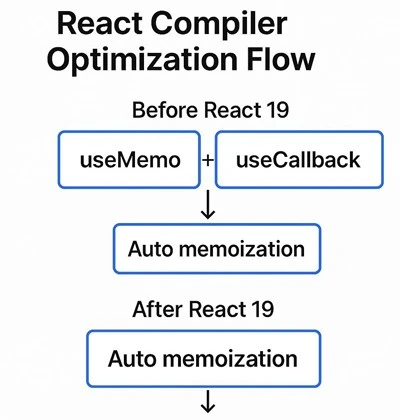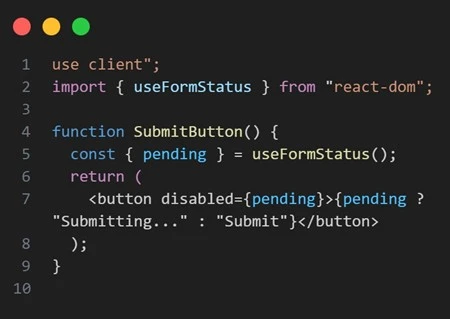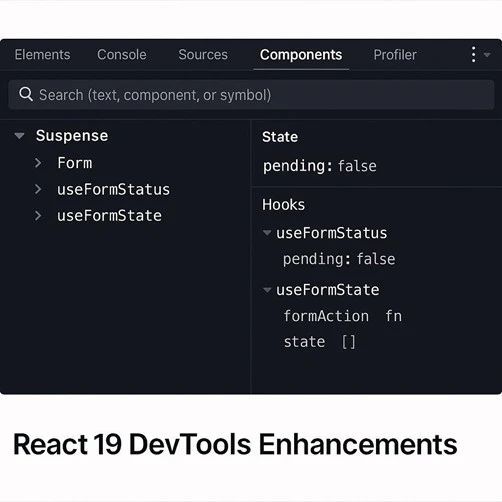
In Part 1 of our React 19 series, we covered major updates like the React Compiler, improved Server Components, new hooks like use(), and enhanced error boundaries. Now, let’s dive deeper into how these features apply in real-world scenarios, explore migration strategies, and share best practices to fully leverage React 19 in your projects.
Real – World Use Cases
1. Optimizing Performance with React Compiler
React 19’s compiler auto-memoizes components, making it ideal for:
- Large dashboards with many re-rendering charts or lists
- High-frequency UI updates, like live chat apps or stock market tickers
Before React 19: Developers had to use useMemo, React.memo, and useCallback manually.
With React 19: Simply opt in to the compiler and enjoy automatic optimizations without cluttering your code.
React Compiler Optimization Flow

2. Server Components in Data-Heavy Apps
Use Server Components to:
- Render large datasets on the server, such as e-commerce product listings or admin panels
- Load only essential JavaScript on the client, improving Time-to-Interactive (TTI)
Example: A blog platform can now render markdown on the server and send minimal HTML
+ hydration code to the browser.
3. Better Form Handling with Actions API
With the new useFormStatus, useFormState, and use() hook:
- You can manage form state and server responses more cleanly
- Perfect for authentication flows, contact forms, or multi-step wizards Example :

4. Improved Error Handling in Production Apps
React 19 now supports async error boundaries. This is helpful for:
- Lazy-loaded components
- Third-party API fetches
Now you can catch rendering failures from suspense or server components more reliably.
- Migration Tips for React 19
| Step | Task |
| 1. | Backup your current project or repo |
| 2. | Update to latest version using `npm install react@19 react-dom@19` |
| 3. | Enable React Compiler in specific components or modules |
| 4. | Test Server Components if you’re on Next.js App Router |
| 5. | Replace form logic with new Actions API for cleaner handling |
| 6. | Wrap risky components in async Error Boundaries |
| 7. | Update third-party packages for compatibility |
Practices to Follow
- Start Small with Compiler: Don’t enable it globally at once. Try it on frequently- updating components first.
- Prefer Server Components for Static or Heavy Data: Avoid unnecessary client-side rendering.
- Avoid State Duplication: Combine useFormState and useFormStatus instead of creating redundant useState fields.
- Use use() in Suspense boundaries carefully: This new hook is powerful but requires a good understanding of promises and SSR.
- Write Clear Error Boundaries: Use fallback UIs that guide users instead of just
showing “Something went wrong.”
Advanced Topics in React 19
1, The use() Hook in Depth
The new use() hook in React 19 allows you to await resources directly inside your components. It’s designed for async/await compatibility in React rendering logic, especially useful for server components or data fetching scenarios.
Best Use Cases:
- Fetching user profiles or dashboard data in server components
- Awaiting third-party API responses in shared layouts
Note: use() only works within the boundaries of React’s server-side environment and Suspense-aware rendering.
2. Concurrent Features Integration:
React 19 embraces concurrent rendering more seamlessly than ever before. It supports transitions and deferred updates to keep UIs responsive even during heavy re-renders.
Benefits:
- Improved user experience during navigation
- Reduced blocking when switching tabs or routes
You can start using startTransition to tell React which updates are less urgent.
3. useFormStatus and useFormState:
These new hooks allow you to manage form UI status and server responses declaratively. They are designed to work hand-in-hand with the Actions API:
- useFormStatus: Manages the state of form submission (pending, success, error)
- useFormState: Tracks response values returned from server actions Example:

4. React 19 and Framework Support:
React 19 is designed to work seamlessly with modern frameworks like Next.js, Remix, and others. If you’re using the App Router in Next.js 13+, React 19 features like Server Components, use(), and Actions API integrate natively and offer a more powerful developer experience.
5. React DevTools Updates:
React DevTools has also received updates to better support the new React 19 features.
- Support for inspecting Suspense boundaries
- Visualizing Server Components
- Hooks support for useFormStatus, useFormState, and more

Conclusion
React 19 is more than just a feature update—it’s a paradigm shift toward simpler, faster, and more efficient React development. By embracing tools like the React Compiler, Server Components, and the Actions API, your app can become more responsive, maintainable, and scalable.
Whether you’re maintaining an existing project or building a new one from scratch, React 19 equips you with powerful tools to modernize your codebase and enhance your development experience.
Stay tuned for Part 3, where we’ll explore advanced performance profiling, community
adoption, and common pitfalls to avoid when using React 19 features.
React 19: New Features & Future Development – Part 3 (Final)
Wrap up the series with Part 3, where we dive into upcoming developer tools, community feedback, and what the future roadmap looks like for React 19 and beyond.

